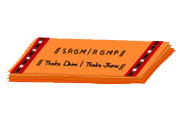Posted By: Administrator
Rāga: Gauḷa
Thāḷa: Chathuraśhra Eka
Composer: Tanjore Quartet
Language: Thamizh(Tamil)
Meanings – Word by word
& Overall:
Alignment, Diacriticals
& consequent spelling changes, Language & grammar editing, if any and
necessary, of existing meaning: Team Ambalam
|| Jheṇṇakiṭṭa Kirrakiṭṭa
Thakkuḍu Dhikkuḍu Tharikiṭa tha ||
|| Thakkiḍu Dhikkiḍu Thakathari Kitathaka Thakkinam Jhekkinam Thaka ||
||
Vinaiyara Vél Vāṅgum Perumān || Aḍiyinai Thozhu Maname Jegajega ||
|| Thomkiṭa Nankiṭa Thomkita
Kitathaki Thomgu Nāngu Thom ||
|| Thom Thahatha - Thokitu Thokita Kitathaki Thokita ||
|| Nanga
Thar Kiṇanakka Jakkaṇakka Tha ||
|| Kānam Mayil Éri Kailāsam
Thannai Suzhala Varum Iḷaiyava- ||
Ne Thozhuvār Thāḷa Vidham Para || Uḍaiyavane
-
|| Jhekita
Jhaṇṇakiṭa Jhaṇakiṭa Jhaṇakiṭa Kiṭathaki Jhaṇakiṭa Kiṭathaki ||
|| Kadal
Kizhiya Malai Muriya Varu Muru - ||
Gan Enai Vinaiya Aruḷadhu Peralām ||
|| Thakkiṭu Thakkiṭa Kiṭathaki
Thakkiṭu
||Thakkiṭu Kiṭathaki Thath
thath Kiṭathaki ||
|| Thakku Dhikki Tha - kiṭṭa Thomkiṭa Kiṭathaka ||
|| Ḍhan Than- ki Kiṭathaka Dhikki Thām -
Thatthathām Thath tha || Tham
Meaning
Vinairara Vél Vāṅgum Perumān Aḍiyinai Thozhu
Maname
Maname - Oh Mind;
Thozhu -Please Worship; Adiyinai -The Feet
Perumān- Of the Lord;
Vāṅgum - Who Took/Accepted
Vél- A Spear; Ara- To Destroy (The consequences of)
Vinai- Our deeds;
Oh mind! Please worship the feet of the Lord who
took up a spear to destroy the consequences of our deeds.
Kanam Mayil Eri Kailayam Tanai Suzhala Varum Ilaiyavanai Tozhuvom
Tozuvom - Let's Worship
Ilaiyavanai - The Younger one
Eri - Who Strode Across The Skies Astride
Kana Mayil - Means A Forest Dwelling Peacock
Suzhala Varum - And Circum ambulated
Kayilayam Tanai - Mount Kailas
Let's worship the younger who strode across the
skies astride a forest dwelling peacock is the circumambulator of mount
Kailāsa.
Tala Mrtangitamudaiyavanai
Tala -
Ankitam Udaiyavanai - One Who Bears
The Signs
Mruḍ = Mruḍa/Mruḍāni - Of Śhiva/Pārvathi
One who bears the signs of Śhiva/Pārvathi
Kadal Kizhiya, Malai Muriya Varum Murugan Arul Petra Kani Adhu Peralam
Peralām - Let Us Obtain
Kani Adu - The Fruit
Arul Petra -blessed
Murugan - By
the Handsome Lord
Varum - Who Has Come
Kizhiya - To Tear-Apart
Kadal - The Sea/Ocean
Muriya - And Splinter
Malai - The Mountain
Let us obtain the fruit that has been blessed by
the handsome lord who has come to tear-apart the ocean and splinter the
mountain.
Note:
●
Vinai
Includes Both The Good (Nal) As Well As The Bad (Th||) Consequences Of Our
Deeds]
●
Iḷaiyavan
- Refers To The Fact That Murugan Is The Younger Son Of Śhiva-Śhakthi (Gaṇeśha
Would Be Mūtthavan – the elder one)












